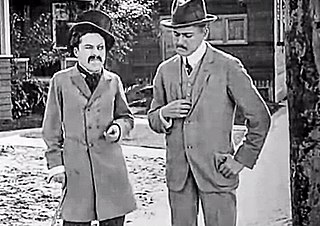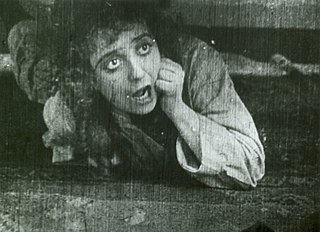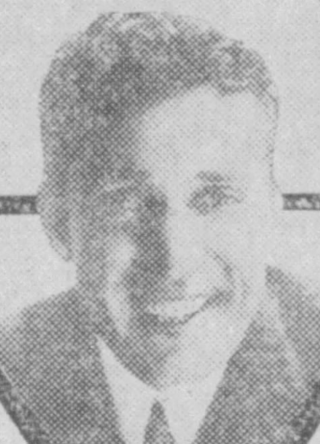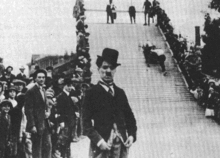
Sir Charles Spencer Chaplin was an English comic actor, filmmaker, and composer who rose to fame in the era of silent film. He became a worldwide icon through his screen persona, the Tramp, and is considered one of the film industry's most important figures. His career spanned more than 75 years, from childhood in the Victorian era until a year before his death in 1977, and encompassed both adulation and controversy.

The Keystone Cops are fictional, humorously incompetent policemen featured in silent film slapstick comedies produced by Mack Sennett for his Keystone Film Company between 1912 and 1917.

Tillie's Punctured Romance is a 1914 American silent comedy film directed by Mack Sennett and starring Marie Dressler, Mabel Normand, Charlie Chaplin, and the Keystone Kops. The picture was the only feature-length comedy made by the Keystone Film Company.

The Tramp, also known as the Little Tramp, was English actor Charlie Chaplin's most memorable on-screen character and an icon in world cinema during the era of silent film. The Tramp is also the title of a silent film starring Chaplin, which Chaplin wrote and directed in 1915.

Making a Living is the first film starring Charlie Chaplin. A one-reel comedy short, it was completed in three days at Keystone Studios in Los Angeles, California and was released for distribution on February 2, 1914. In it Chaplin portrays a charming swindler who runs afoul of a news reporter and a Keystone Cop. In addition to co-writing the "scenario" and directing the production, Henry Lehrman performs as the principal supporting character.

Twenty Minutes of Love is a 1914 American comedy silent film made by Keystone Studios. The film is widely reported as Charlie Chaplin's directorial debut; some sources name Joseph Maddern as the director, but generally credit Chaplin as the creative force.

Between Showers is a 1914 short film made by Keystone Studios and directed by Henry Lehrman. It starred Charlie Chaplin, Ford Sterling, Emma Clifton, and Chester Conklin.

Henry Lehrman was an American actor, screenwriter, director and producer. Lehrman was a very prominent figure of Hollywood's silent film era, working with such cinematic pioneers as D. W. Griffith and Mack Sennett. He directed, as well as co-starred in, Charlie Chaplin's very first film, Making a Living.

The Knockout is a 1914 American silent comedy film starring Roscoe "Fatty" Arbuckle. It also features Charlie Chaplin in a small role, his seventeenth film for Keystone Studios. It is one of only a few films in which Chaplin's Little Tramp character appears in a secondary role, not appearing until the second half of the film. It also stars Arbuckle's wife, Minta Durfee, Edgar Kennedy and Keystone owner, Mack Sennett in a minor role as a spectator. The film was directed by Charles Avery.
Edendale is a historical name for a district in Los Angeles, California, northwest of Downtown Los Angeles, in what is known today as Echo Park, Los Feliz and Silver Lake. In the opening decades of the 20th century, in the era of silent movies, Edendale was known as the home of most major movie studios on the West Coast. Among its many claims, it was home to the Keystone Kops, and the site of many movie firsts, including Charlie Chaplin's first movie, the first feature-length comedy, and the first pie-in-the-face. The Edendale movie studios were mostly concentrated in a four-block stretch of Allesandro Street, between Berkeley Avenue and Duane Street. Allesandro Street was later renamed Glendale Boulevard.

His New Job is a 1915 American short silent comedy film written by, directed by, and starring Charlie Chaplin. Gloria Swanson appears as an uncredited extra. The title is an inside reference to this being Chaplin's first film after leaving Keystone Studios for Essanay Studios. It was also the only film Chaplin shot at Essanay's Chicago studio. He found the facilities and climate not to his liking, and Chaplin soon relocated back to California.

Mabel's Busy Day is a 1914 short comedy film starring Mabel Normand and Charles Chaplin; the film was also written and directed by Mabel Normand. The supporting cast includes Chester Conklin, Slim Summerville, Edgar Kennedy, Al St. John, Charley Chase, and Mack Sennett.

(Sir) Charlie Chaplin (KBE) (1889–1977) was an English-born internationally renowned Academy Award-winning actor, comedian, filmmaker and composer whose was best known for his career in Hollywood motion pictures from 1914 until 1952, he subsequently appeared in two films in his native England. During his early years in the era of silent film, he rose to prominence as a worldwide cinematic idol renowned for his tramp persona. In the 1910s and 1920s, he was considered the most famous person on the planet.

Mabel's Strange Predicament is a 1914 American film starring Mabel Normand and Charles Chaplin, notable for being the first film for which Chaplin donned the costume of The Tramp, although his appearance in the costume in Kid Auto Races at Venice was released first. The film was directed by Normand and produced by Mack Sennett.

Those Love Pangs, also known as The Rival Mashers, is a 1914 American silent comedy film. It was produced by Keystone Studios and starred Charlie Chaplin and Chester Conklin.

The L-KO Kompany, or L-KO Komedies, was an American motion picture company founded by Henry Lehrman that produced silent one-, two- and very occasionally three-reel comedy shorts between 1914 and 1919. The initials L-KO stand for "Lehrman KnockOut".
Olives and Their Oil is a 1914 educational short film about the production of olive oil. The film was released by Keystone Studios on February 7, 1914, on a split reel with the Charlie Chaplin comedy Kid Auto Races at Venice.

Frank D. Williams was a pioneering cinematographer who was active in the early days of the motion picture industry. He developed and patented the traveling matte shot.

William Hill, known professionally as Billie Ritchie, was a Scottish comedian who first gained transatlantic fame as a performer for British music hall producer Fred Karno — thus, a full decade before Stan Laurel and Charlie Chaplin took a similar career path. Ritchie is best recalled today for the silent comedy shorts he made between 1914 and 1920 for director/producer Henry Lehrman's L-KO Kompany and Fox Film Sunshine Comedy unit.
Enrique Juan Vallejo was a Mexican cinematographer and film director.

















